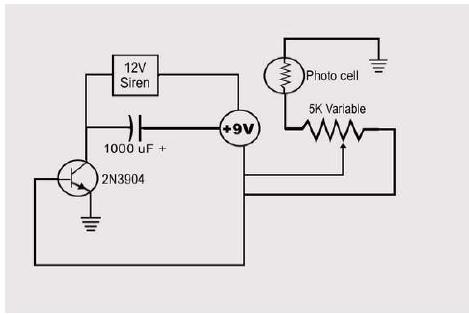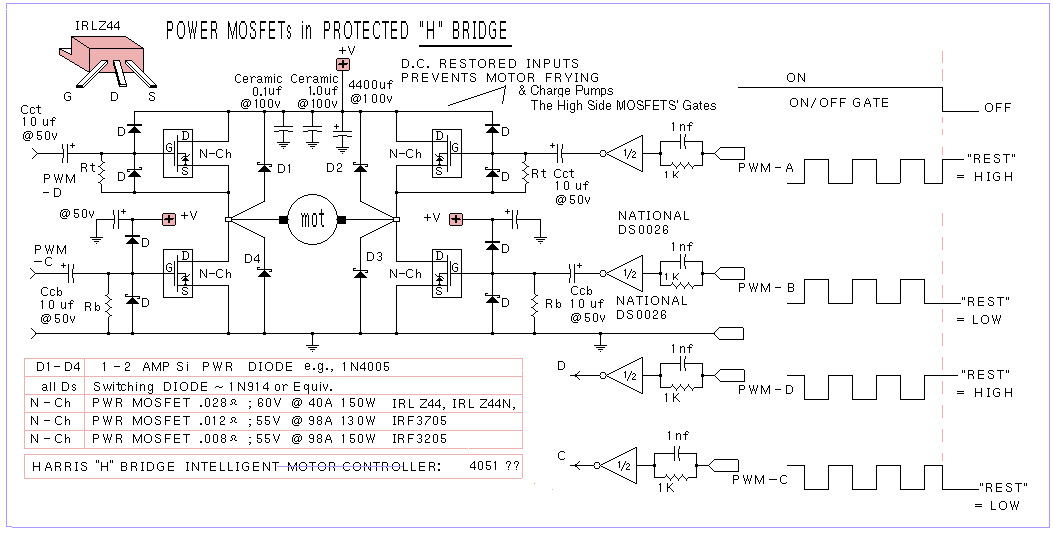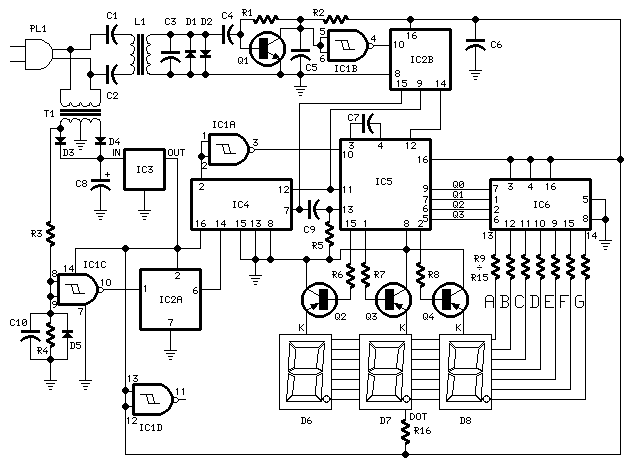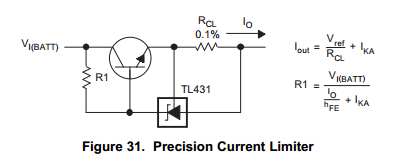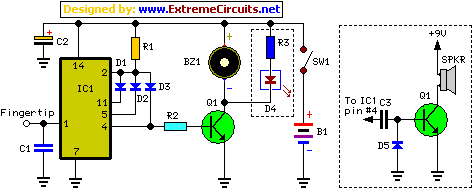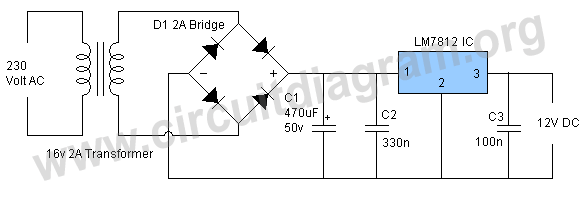
A Repeating Timer Circuit
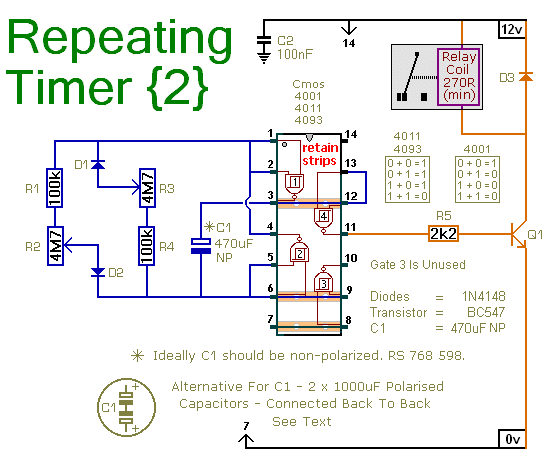
This circuit is based on a simple asymmetric oscillator. The duration for which the relay remains energized and the duration for which it remains de-energized are independently set. With the component values indicated in the diagram, both durations are adjustable from approximately 1 to 30 minutes. The frequency of the astable oscillator is determined by the value of C1 and the rate at which it charges and discharges through the resistor network. The time the relay remains energized is controlled by R2, while the time it remains de-energized is controlled by R3. Due to manufacturing tolerances, the exact duration of the time periods depends on the characteristics of the actual components used. R1 and R4 establish the minimum period lengths at about 1 minute, while R2 and R3 set the maximum periods at approximately 30 minutes. Users can select component values that meet their specific requirements. If precise timing is not critical, the potentiometers can be omitted, relying solely on R1 and R4 to set the times. The on-board relay should not be used to switch mains voltage, as the board layout does not provide adequate isolation between the relay contacts and the low-voltage components. For switching mains voltage, a suitably rated relay should be mounted safely away from the board. A single-pole, single-throw (SPST) or single-pole, double-throw (SPDT) relay is recommended, although a multi-pole relay can be used if applicable. A regular electrolytic capacitor is polarized; if the charge on its plates is reversed, DC current can flow through the capacitor, potentially causing it to heat up and explode. The polarity of the charge on C1 reverses while the oscillator is running, necessitating a non-polarized capacitor. However, a non-polarized 470µF capacitor can be simulated by connecting two 1000µF polarized capacitors back to back, as explained in the detailed circuit. Since non-polarized capacitors are not widely available, the prototype was constructed using two polarized capacitors. The timer is designed for a 12-volt power supply but will function within a range of 5 to 15 volts, provided a relay suitable for the supply voltage is selected. The CMOS gates function as simple inverters, so while a CMOS 4093 is utilized in the circuit diagram, a CMOS 4001 or CMOS 4011 can also be employed. Supporting materials for this circuit include a step-by-step construction guide for the circuit board, a parts list, a detailed circuit description, and additional resources.
This circuit operates as an asymmetric oscillator, allowing independent control over the relay's energized and de-energized states. The astable oscillator's frequency is influenced by the capacitor C1, which charges and discharges through the resistor network formed by R2 and R3. The adjustable timing is achieved through a combination of fixed resistors (R1 and R4) and variable resistors (R2 and R3), permitting customization of the timing intervals from 1 to 30 minutes.
The relay's operation is critical in applications where timing control is essential. The circuit's design incorporates safety measures, particularly regarding the handling of mains voltage. Users are advised to employ an external relay for high-voltage applications, ensuring safe operation by maintaining adequate distance from low-voltage components.
The use of non-polarized capacitors is essential in this design to prevent damage from incorrect polarity. The back-to-back configuration of two polarized capacitors effectively simulates a non-polarized capacitor, allowing the circuit to function correctly without risk of failure due to capacitor damage. This design choice is particularly useful in environments where non-polarized capacitors may be unavailable.
The circuit is versatile, operating efficiently within a power supply range of 5 to 15 volts, making it adaptable for various applications. The choice of CMOS logic gates provides flexibility in component selection, allowing for the use of alternative gates without compromising functionality.
Overall, this circuit exemplifies a practical approach to timing control in electronic applications, with a focus on safety, adaptability, and ease of construction. Supporting documentation enhances user understanding and facilitates effective implementation of the circuit.This circuit is based on a simple asymmetric oscillator. The length of time the relay remains energized - and the length of time it remains de-energized - are set independently. With the component values shown in the diagram - both periods are adjustable from about 1 to 30 minutes.
The frequency of the Astable Oscillator depends on the value of C1 and the speed at which it charges and discharges through the resistor network. The length of time the relay remains energized is controlled by R2. And the length of the time it remains de-energized is controlled by R3. Owing to manufacturing tolerances - the precise length of the time periods available depends on the characteristics of the actual components you`ve used. R1 & R4 set the minimum period lengths at about 1-minute - while R2 & R3 set the maximum periods at about 30-minutes.
You can choose component values that suit your own requirements. If your time periods don`t need to be too precise - and more-or-less is close enough - you can leave out the pots altogether - and simply rely on R1 & R4 to set the times. Do not use the "on-board" relay to switch mains voltage. The board`s layout does not offer sufficient isolation between the relay contacts and the low-voltage components.
If you want to switch mains voltage - mount a suitably rated relay somewhere safe - Away From The Board. I`ve used a SPCO/SPDT relay - but you can use a multi-pole relay if it suits your application. A regular electrolytic capacitor is polarised. If the charge on its plates is the wrong way round - DC current will flow through the capacitor. If the current is high enough - the capacitor will heat up and explode. When the oscillator is running - the polarity of the charge on C1 keeps reversing. So C1 needs to be non-polarised. However - you can simulate a non-polarised 470uF capacitor by connecting two 1000uF polarised capacitors back to back - as shown.
How and why this works is explained in the Detailed Circuit Because non-polarised capacitors aren`t widely available - the prototype was built using two polarised capacitors. The timer is designed for a 12-volt power supply. However - it will work at anything from 5 to 15-volts. All you need do is select a relay to suit your supply voltage. The Cmos gates are being used as simple inverters. So - although I`ve used a Cmos 4093 in the circuit diagram - a Cmos 4001 or Cmos 4011 will work just as well.
The Support Material for this circuit includes a step-by-step guide to the construction of the circuit-board - a parts list - a detailed circuit description - and more. 🔗 External reference
This circuit operates as an asymmetric oscillator, allowing independent control over the relay's energized and de-energized states. The astable oscillator's frequency is influenced by the capacitor C1, which charges and discharges through the resistor network formed by R2 and R3. The adjustable timing is achieved through a combination of fixed resistors (R1 and R4) and variable resistors (R2 and R3), permitting customization of the timing intervals from 1 to 30 minutes.
The relay's operation is critical in applications where timing control is essential. The circuit's design incorporates safety measures, particularly regarding the handling of mains voltage. Users are advised to employ an external relay for high-voltage applications, ensuring safe operation by maintaining adequate distance from low-voltage components.
The use of non-polarized capacitors is essential in this design to prevent damage from incorrect polarity. The back-to-back configuration of two polarized capacitors effectively simulates a non-polarized capacitor, allowing the circuit to function correctly without risk of failure due to capacitor damage. This design choice is particularly useful in environments where non-polarized capacitors may be unavailable.
The circuit is versatile, operating efficiently within a power supply range of 5 to 15 volts, making it adaptable for various applications. The choice of CMOS logic gates provides flexibility in component selection, allowing for the use of alternative gates without compromising functionality.
Overall, this circuit exemplifies a practical approach to timing control in electronic applications, with a focus on safety, adaptability, and ease of construction. Supporting documentation enhances user understanding and facilitates effective implementation of the circuit.This circuit is based on a simple asymmetric oscillator. The length of time the relay remains energized - and the length of time it remains de-energized - are set independently. With the component values shown in the diagram - both periods are adjustable from about 1 to 30 minutes.
The frequency of the Astable Oscillator depends on the value of C1 and the speed at which it charges and discharges through the resistor network. The length of time the relay remains energized is controlled by R2. And the length of the time it remains de-energized is controlled by R3. Owing to manufacturing tolerances - the precise length of the time periods available depends on the characteristics of the actual components you`ve used. R1 & R4 set the minimum period lengths at about 1-minute - while R2 & R3 set the maximum periods at about 30-minutes.
You can choose component values that suit your own requirements. If your time periods don`t need to be too precise - and more-or-less is close enough - you can leave out the pots altogether - and simply rely on R1 & R4 to set the times. Do not use the "on-board" relay to switch mains voltage. The board`s layout does not offer sufficient isolation between the relay contacts and the low-voltage components.
If you want to switch mains voltage - mount a suitably rated relay somewhere safe - Away From The Board. I`ve used a SPCO/SPDT relay - but you can use a multi-pole relay if it suits your application. A regular electrolytic capacitor is polarised. If the charge on its plates is the wrong way round - DC current will flow through the capacitor. If the current is high enough - the capacitor will heat up and explode. When the oscillator is running - the polarity of the charge on C1 keeps reversing. So C1 needs to be non-polarised. However - you can simulate a non-polarised 470uF capacitor by connecting two 1000uF polarised capacitors back to back - as shown.
How and why this works is explained in the Detailed Circuit Because non-polarised capacitors aren`t widely available - the prototype was built using two polarised capacitors. The timer is designed for a 12-volt power supply. However - it will work at anything from 5 to 15-volts. All you need do is select a relay to suit your supply voltage. The Cmos gates are being used as simple inverters. So - although I`ve used a Cmos 4093 in the circuit diagram - a Cmos 4001 or Cmos 4011 will work just as well.
The Support Material for this circuit includes a step-by-step guide to the construction of the circuit-board - a parts list - a detailed circuit description - and more. 🔗 External reference
Warning: include(partials/cookie-banner.php): Failed to open stream: Permission denied in /var/www/html/nextgr/view-circuit.php on line 713
Warning: include(): Failed opening 'partials/cookie-banner.php' for inclusion (include_path='.:/usr/share/php') in /var/www/html/nextgr/view-circuit.php on line 713
